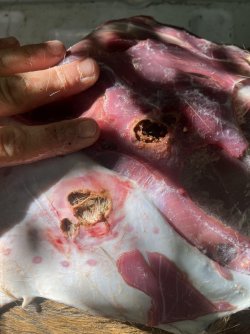Our first rifle deer season arrived here in Missouri this weekend and both my boys ended up shooting their first deer, a whitetail doe, using the 0.257" SBD2 110gr.
The rifle used was a Howa 1500 25-06AI with 26" 1:7" and Omega 300 suppressor, an 11# rifle fully loaded, so I don't want to hear any complaints about an adult that thinks a 10# rifle is heavy

Muzzle velocity on this load is 3421fps.
The first deer shot yesterday was a young doe and the shot was taken almost perfectly broadside at 75 yards. Impact velocity was approximately 3305fps with 2668ft.# of energy. Bullet impact perfectly mid body, but back near the last rib. Exit was slightly forward of that on the opposite side. Per usual, entrance hole what bullet diameter and exit was slightly larger than 1" with evidence that there was some amount of fragmentation with multiple small exit holes surrounding the shank exit hole. The bullet destroyed the liver with additional damage to the rumen and minor damage to one lung lobe. There were a few dark spots of blood at POI, but there was no additional blood to be found for the first 100 yards of the path the deer ran. Once blood trail started, the deer lasted another 20 yards. I would have preferred that the shot be further forward into the front shoulder, but even I have made this same shot before so I can't fault a 6-year old too much.
How doe was found with exit wound facing up.
View attachment 500078
Damage done to liver
View attachment 500079
Exit hole showing possible fragmentation.
View attachment 500081
The second deer shot with this bullet was a mature doe with much different shot placement. Doe was in the same shooting lane and virtually the same position but about 5 yards closer. Bullet entered in the front leg and exited just behind the crease in the opposite side. She ran a total of 15 yards and last maybe two seconds.
Bullet and bone fragmentation was significant with this shot and destruction was unlike anything I have seen with a solid copper bullet, not even my 300 PRC. Blood trail was very significant and had bright red blood sprayed all over the vegetation for the full 15 yards. My 8-year old easily blood trailed the deer without assistance. Again, entrance was roughly bullet diameter and exit was roughly 1", but internal damage was a much more than the exterior suggested. The front leg where the bullet entered was completely broken and I found copper fragments under the hide on opposite side.
Second deer showing entrance hole in front shoulder.
View attachment 500083
Thumb pointing at location of bullet entry. Blood under skin all the way to the back of the ribs.
View attachment 500084
After removing front quarter the bullets entrance into the chest cavity was found. Nearly a 3" opening just forward of the heart. Significant blood found through, but it appeared to not be bloodshot meat, just pooled and coagulated blood.
View attachment 500085
Bullet exit behind the crease. ~1" exit.
View attachment 500086
Chest cavity at bullet exit.
View attachment 500087
Copper fragments under hide on opposite side
View attachment 500088
In addition to being grateful for harvesting these two animals and sharing that experience with my kids for their first deer, I was pleased to be able to see two very different shot placements in the same day with the exact same bullet.
One shot was a little too far back for my liking and one was hard into the front shoulder.
The one that was too far back had very minimal impact with bone and blood trail was nearly non-existent. The shot into the shoulder had significant bone impact and significant trauma to the circulatory system, spraying blood out of the exit wound.
The biggest lesson reinforced today is, "put the bullet in the right spot". For me that is into the heart/lung area and not behind the crease. I have shot deer with lead core bullets too far back and have had the same results, dead deer but no blood trail. Same thing with lead core on elk. Shot in liver, ran 100 yards, but no blood trail.
This is the behavior I was hoping to see with this bullet as I have cautiously been approaching the idea of using it on elk this fall. I am very confident in that choice now for distances out to 400 yards. I know many won't consider that long range, but when I rarely shoot deer past 100, 400 is pretty far out there.

